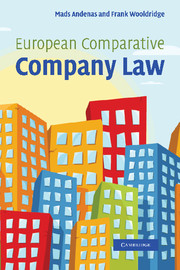Book contents
- Frontmatter
- Contents
- Preface
- Table of Cases
- Table of Legislation
- 1 Introduction
- 2 European and comparative company law
- 3 Formation of companies
- 4 The types of business organisation
- 5 Share (or equity) capital and loan capital
- 6 Management and control of companies
- 7 Business entities governed by Community law
- 8 Employee participation
- 9 Groups of companies
- 10 Cross-border mergers and acquisitions
- 11 Investor protection
- Index
- References
2 - European and comparative company law
Published online by Cambridge University Press: 04 August 2010
- Frontmatter
- Contents
- Preface
- Table of Cases
- Table of Legislation
- 1 Introduction
- 2 European and comparative company law
- 3 Formation of companies
- 4 The types of business organisation
- 5 Share (or equity) capital and loan capital
- 6 Management and control of companies
- 7 Business entities governed by Community law
- 8 Employee participation
- 9 Groups of companies
- 10 Cross-border mergers and acquisitions
- 11 Investor protection
- Index
- References
Summary
Harmonisation and free movement
Treaty provisions
It is now recognised generally that although there is no question of the total approximation or harmonisation of the company laws of the Member States, a considerable body of European company law has been brought into existence. This has come about mainly through the enactment of directives under Articles 44(2)(g) and 95 EC (former Articles 54(3)(g), 100a EC). The first mentioned Article is set out in Chapter 2, ‘Right of establishment of Title II EC, “free movement of persons, services and capital”’. It provides:
The Council and the Commission shall carry out the duties devolving on them under the preceding provisions, in particular (g) by coordinating to the necessary extent the safeguards which for the protection of the interests of members and others, are required by Member States of companies within the meaning of Article 48(2) with a view to making such safeguards equivalent throughout the community.
Article 44(2)(g) EC is the basis for nearly all enacted directives in European company law. Despite its position in Chapter 2 of the Treaty, the Community institutions pursue a broad interpretation which is orientated towards the aims of the Treaty. In that view also measures with the purpose of approximating the prevailing conditions of company law can be based on it as long as they have beneficial effect on cross-border transactions.
- Type
- Chapter
- Information
- European Comparative Company Law , pp. 7 - 51Publisher: Cambridge University PressPrint publication year: 2009
References
- 3
- Cited by



